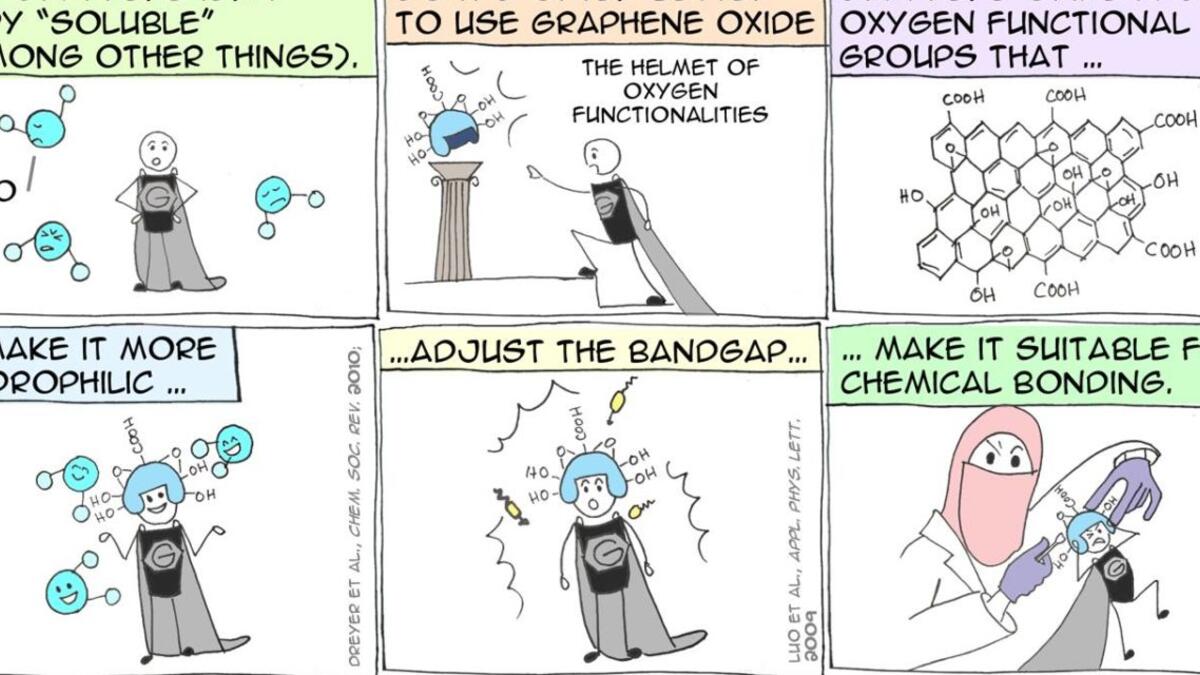Picture this: Pakistani scholar brings illustrative twist to Thesis

The “cartoon Qudsia” illustrates the complexities of chemical bonds with a superhero graphene molecule. Image courtesy of Syeda Qudsia.
If a picture is worth a thousand words then Syeda Qudsia’s master’s thesis must be worth at least 40,000 words. In March, she successfully defended her thesis at the National University of Sciences and Technology in Islamabad, Pakistan on the applications of graphene oxide for solar cells, using cartoons.
Syeda Qudsia attended Arizona State University last year as part of an exchange program with the U.S.-Pakistan Centers for Advanced Studies in Energy, better known as USPCAS-E, that seeks to brighten the lives of her fellow compatriots and be part of the solution for Pakistan’s energy crisis by developing skilled energy professionals.
“I chose a comic strip format because it is a great medium for storytelling and it makes everything so much more interesting,” Qudsia explained.
Like her cartoon alter-ego featured in her thesis, Qudsia is known for wearing her traditional hijab and veil hijab but also dons her trademark Converse sneakers. The “cartoon Qudsia” illustrates the complexities of chemical bonds with a superhero graphene molecule.
“We modified graphene oxide with a chemical compound, believing that it would change the electrical properties of the material. And it did,” she discovered.
The work she conducted in electrical engineering Assistant Professor Zachary Holman’s lab in the Ira A. Fulton Schools of Engineering at ASU was on silicon nanoparticles, aimed at improving the efficiency of silicon solar cells. This experience polished her skills and helped her complete her research on graphene oxide’s role in similar solar cell applications back in Pakistan.
Qudsia believed that most science presentations were tedious and dull, and although she felt like she was breaking the rules of traditional science presentations, her thesis was well-received amongst her peers and advisors.
Syeda Qudsia (center) playfully throws the ASU fork in her trademark Converse sneakers. Photographer: Erika Gronek/ASU
“Sometimes people cannot cover the gap-of-knowledge between the audience and the presenter,” she said, but her project certainly bridged that gap and made technical concepts more approachable.
In the spring of 2017 she graduated from NUST in Pakistan with a master’s of science in nanoscience and engineering. Currently, Qudsia is in the process of applying for a doctoral position in solar cell research with the hope of contributing to energy research.
Qudsia was grateful for the USPCAS-E program and the many opportunities availed for her to grow personally and professionally. She credits ASU’s research facilities as an integral part of her success.
USPCAS-E is based at ASU and is a collaboration sponsored by the U.S. Agency for International Development and Pakistan’s Higher Education Commission in conjunction with two leading Pakistani engineering universities. It aims to train and enable students to be change agents in helping both countries improve their energy systems.
More Science and technology

ASU and Deca Technologies selected to lead $100M SHIELD USA project to strengthen U.S. semiconductor packaging capabilities
The National Institute of Standards and Technology — part of the U.S. Department of Commerce — announced today that it plans to…

From food crops to cancer clinics: Lessons in extermination resistance
Just as crop-devouring insects evolve to resist pesticides, cancer cells can increase their lethality by developing resistance to…

ASU professor wins NIH Director’s New Innovator Award for research linking gene function to brain structure
Life experiences alter us in many ways, including how we act and our mental and physical health. What we go through can even…
